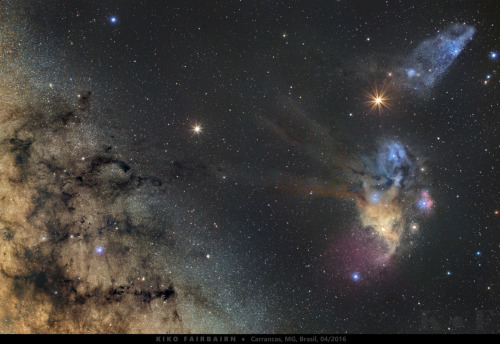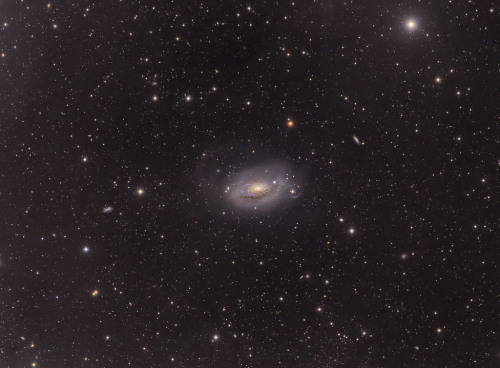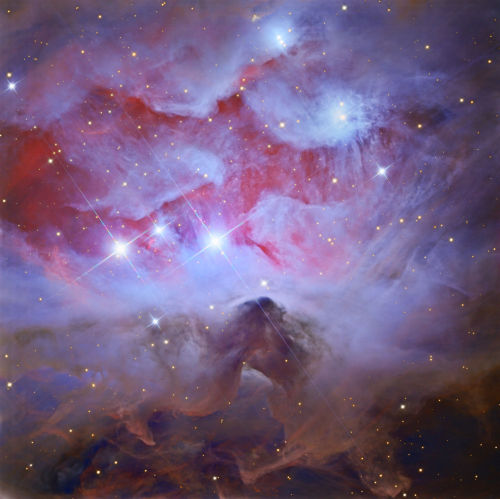NGC 7129, Young Stars

NGC 7129, Young Stars
More Posts from Littlecadet-biguniverse and Others


Mercury is passing directly across the sun for the first time in nearly a decade.
The innermost planet of our solar system will look like a small, dark circle cutting across the sun’s disc. In the U.S., the transit began shortly after 7 a.m. ET on Monday and will continue for more than seven hours.
At least part of the transit, which only happens about 13 times every century, will be visible across the Americas, Europe, Africa and large portions of Asia.
If you’re hoping to watch it, eye protection is key. NASA stresses that “viewing this event safely requires a telescope or high-powered binoculars fitted with solar filters made of specially-coated glass or Mylar.”
You won’t be able to see the tiny dot of Mercury on its celestial crawl without magnification, NASA says.
Another option: Check out one of the multiple live-streaming events going on Monday. NASA says it will stream the transit here, here and here.
It’s not all about the show — transits like this one have historically been, and continue to be, important research opportunities for scientists. First observed in 1631, the transits were later used to “measure the distance between the Earth and the Sun,”NASA said.
Now, they provide scientists an opportunity to study the planets’ exospheres — the thin layer of gases that make up their atmosphere.
“When Mercury is in front of the sun, we can study the exosphere close to the planet,” NASA scientist Rosemary Killen said in a release from the Jet Propulsion Laboratory. “Sodium in the exosphere absorbs and re-emits a yellow-orange color from sunlight, and by measuring that absorption, we can learn about the density of gas there.”
Additionally, scientists have found that a transiting planet causes a drop in the sun’s brightness.
This phenomenon is “the main way we find planets outside the solar system,” NASA says.
The Kepler mission, which is searching for habitable planets, has found 1,041 planets to date using the transit method. The mission says it is able to determine the size of a planet by observing its transit.
Image Credit: NASA

Wings of a butterfly nebula.
Image Credit: Hubble Legacy Archive, NASA, ESA - Processing: Judy Schmidt

Saturn and Mars visit Milky Way Star Clouds
js

M63 // Sunflower Galaxy

Herschel’s Eagle Nebula, some 6,500 light-years away.
Image Credit & Copyright: ESA/Herschel/PACS, SPIRE/Hi-GAL Project

Running Man Nebula
js

A Black Hole Choir : The blue dots in this field of galaxies, known as the COSMOS field, show galaxies that contain supermassive black holes emitting high-energy X-rays.
js


Jupiter’s North Pole Unlike Anything Encountered in Solar System
NASA’s Juno spacecraft has sent back the first-ever images of Jupiter’s north pole, taken during the spacecraft’s first flyby of the planet with its instruments switched on. The images show storm systems and weather activity unlike anything previously seen on any of our solar system’s gas-giant planets. “First glimpse of Jupiter’s north pole, and it looks like nothing we have seen or imagined before,” said Scott Bolton, principal investigator of Juno from the Southwest Research Institute in San Antonio. “It’s bluer in color up there than other parts of the planet, and there are a lot of storms. There is no sign of the latitudinal bands or zone and belts that we are used to – this image is hardly recognizable as Jupiter. We’re seeing signs that the clouds have shadows, possibly indicating that the clouds are at a higher altitude than other features.”
Credit: NASA/JPL-Caltech/SwRI/MSSS
Getting to Mars: 4 Things We’re Doing Now
We’re working hard to send humans to Mars in the 2030s. Here are just a few of the things we’re doing now that are helping us prepare for the journey:
1. Research on the International Space Station

The International Space Station is the only microgravity platform for the long-term testing of new life support and crew health systems, advanced habitat modules and other technologies needed to decrease reliance on Earth.

When future explorers travel to the Red Planet, they will need to be able to grow plants for food, atmosphere recycling and physiological benefits. The Veggie experiment on space station is validating this technology right now! Astronauts have grown lettuce and Zinnia flowers in space so far.

The space station is also a perfect place to study the impacts of microgravity on the human body. One of the biggest hurdles of getting to Mars in ensuring that humans are “go” for a long-duration mission. Making sure that crew members will maintain their health and full capabilities for the duration of a Mars mission and after their return to Earth is extremely important.

Scientists have solid data about how bodies respond to living in microgravity for six months, but significant data beyond that timeframe had not been collected…until now! Former astronaut Scott Kelly recently completed his Year in Space mission, where he spent a year aboard the space station to learn the impacts of microgravity on the human body.
A mission to Mars will likely last about three years, about half the time coming and going to Mars and about half the time on the Red Planet. We need to understand how human systems like vision and bone health are affected and what countermeasures can be taken to reduce or mitigate risks to crew members.
2. Utilizing Rovers & Tech to Gather Data

Through our robotic missions, we have already been on and around Mars for 40 years! Before we send humans to the Red Planet, it’s important that we have a thorough understanding of the Martian environment. Our landers and rovers are paving the way for human exploration. For example, the Mars Reconnaissance Orbiter has helped us map the surface of Mars, which will be critical in selecting a future human landing site on the planet.

Our Mars 2020 rover will look for signs of past life, collect samples for possible future return to Earth and demonstrate technology for future human exploration of the Red Planet. These include testing a method for producing oxygen from the Martian atmosphere, identifying other resources (such as subsurface water), improving landing techniques and characterizing weather, dust and other potential environmental conditions that could affect future astronauts living and working on Mars.

We’re also developing a first-ever robotic mission to visit a large near-Earth asteroid, collect a multi-ton boulder from its surface and redirect it into a stable orbit around the moon. Once it’s there, astronauts will explore it and return with samples in the 2020s. This Asteroid Redirect Mission (ARM) is part of our plan to advance new technologies and spaceflight experience needed for a human mission to the Martian system in the 2030s.
3. Building the Ride
Okay, so we’ve talked about how we’re preparing for a journey to Mars…but what about the ride? Our Space Launch System, or SLS, is an advanced launch vehicle that will help us explore beyond Earth’s orbit into deep space. SLS will be the world’s most powerful rocket and will launch astronauts in our Orion spacecraft on missions to an asteroid and eventually to Mars.

In the rocket’s initial configuration it will be able to take 154,000 pounds of payload to space, which is equivalent to 12 fully grown elephants! It will be taller than the Statue of Liberty and it’s liftoff weight will be comparable to 8 fully-loaded 747 jets. At liftoff, it will have 8.8 million pounds of thrust, which is more than 31 times the total thrust of a 747 jet. One more fun fact for you…it will produce horsepower equivalent to 160,000 Corvette engines!

Sitting atop the SLS rocket will be our Orion spacecraft. Orion will be the safest most advanced spacecraft ever built, and will be flexible and capable enough to carry humans to a variety of destinations. Orion will serve as the exploration vehicle that will carry the crew to space, provide emergency abort capability, sustain the crew during space travel and provide safe re-entry from deep space return velocities.
4. Making it Sustainable
When humans get to Mars, where will they live? Where will they work? These are questions we’ve already thought about and are working toward solving. Six partners were recently selected to develop ground prototypes and/or conduct concept studies for deep space habitats.

These NextSTEP habitats will focus on creating prototypes of deep space habitats where humans can live and work independently for months or years at a time, without cargo supply deliveries from Earth.

Another way that we are studying habitats for space is on the space station. In June, the first human-rated expandable module deployed in space was used. The Bigelow Expandable Activity Module (BEAM) is a technology demonstration to investigate the potential challenges and benefits of expandable habitats for deep space exploration and commercial low-Earth orbit applications.
Our journey to Mars requires preparation and research in many areas. The powerful new Space Launch System rocket and the Orion spacecraft will travel into deep space, building on our decades of robotic Mars explorations, lessons learned on the International Space Station and groundbreaking new technologies.
Make sure to follow us on Tumblr for your regular dose of space: http://nasa.tumblr.com

Our Moon along with Jupiter and it’s 4 largest moons.
Image Credit & Copyright: Cristian Fattinnanzi
-
 laoban77 liked this · 5 years ago
laoban77 liked this · 5 years ago -
 igivewhatigot liked this · 5 years ago
igivewhatigot liked this · 5 years ago -
 yxcvbnm666 liked this · 6 years ago
yxcvbnm666 liked this · 6 years ago -
 ayyyy-love liked this · 6 years ago
ayyyy-love liked this · 6 years ago -
 archangel-wings01 reblogged this · 6 years ago
archangel-wings01 reblogged this · 6 years ago -
 peroxidebutch liked this · 6 years ago
peroxidebutch liked this · 6 years ago -
 alexanderreaderp liked this · 6 years ago
alexanderreaderp liked this · 6 years ago -
 tayloer123 liked this · 6 years ago
tayloer123 liked this · 6 years ago -
 yourawkwardbean liked this · 6 years ago
yourawkwardbean liked this · 6 years ago -
 ltd68 liked this · 6 years ago
ltd68 liked this · 6 years ago -
 rosethevoid liked this · 6 years ago
rosethevoid liked this · 6 years ago -
 recklesslystudying-blog liked this · 6 years ago
recklesslystudying-blog liked this · 6 years ago -
 analog-machine liked this · 6 years ago
analog-machine liked this · 6 years ago -
 alirose62 liked this · 6 years ago
alirose62 liked this · 6 years ago -
 bluejort liked this · 6 years ago
bluejort liked this · 6 years ago -
 walkerff liked this · 6 years ago
walkerff liked this · 6 years ago -
 ententionally liked this · 6 years ago
ententionally liked this · 6 years ago -
 podunk73-blog liked this · 7 years ago
podunk73-blog liked this · 7 years ago -
 skysnow9 liked this · 7 years ago
skysnow9 liked this · 7 years ago -
 chimnotkim-blog liked this · 8 years ago
chimnotkim-blog liked this · 8 years ago -
 pearlnoir liked this · 8 years ago
pearlnoir liked this · 8 years ago -
 clemdem reblogged this · 8 years ago
clemdem reblogged this · 8 years ago -
 bigwitchtitts liked this · 8 years ago
bigwitchtitts liked this · 8 years ago -
 dumza liked this · 8 years ago
dumza liked this · 8 years ago -
 hellokittypee liked this · 8 years ago
hellokittypee liked this · 8 years ago -
 exell24 liked this · 8 years ago
exell24 liked this · 8 years ago -
 sylencr reblogged this · 8 years ago
sylencr reblogged this · 8 years ago -
 sylencr liked this · 8 years ago
sylencr liked this · 8 years ago -
 floralprintsharks reblogged this · 8 years ago
floralprintsharks reblogged this · 8 years ago -
 gloriyamt-blog liked this · 8 years ago
gloriyamt-blog liked this · 8 years ago -
 capuchin24 liked this · 8 years ago
capuchin24 liked this · 8 years ago -
 medusaesque reblogged this · 8 years ago
medusaesque reblogged this · 8 years ago -
 lyricwritesprose reblogged this · 8 years ago
lyricwritesprose reblogged this · 8 years ago -
 techmela-blog reblogged this · 8 years ago
techmela-blog reblogged this · 8 years ago -
 ljack3030-blog liked this · 8 years ago
ljack3030-blog liked this · 8 years ago -
 blackandbluekangaroo liked this · 8 years ago
blackandbluekangaroo liked this · 8 years ago -
 astridbeauregard reblogged this · 8 years ago
astridbeauregard reblogged this · 8 years ago
GREETINGS FROM EARTH! Welcome to my space blog! Let's explore the stars together!!!
144 posts